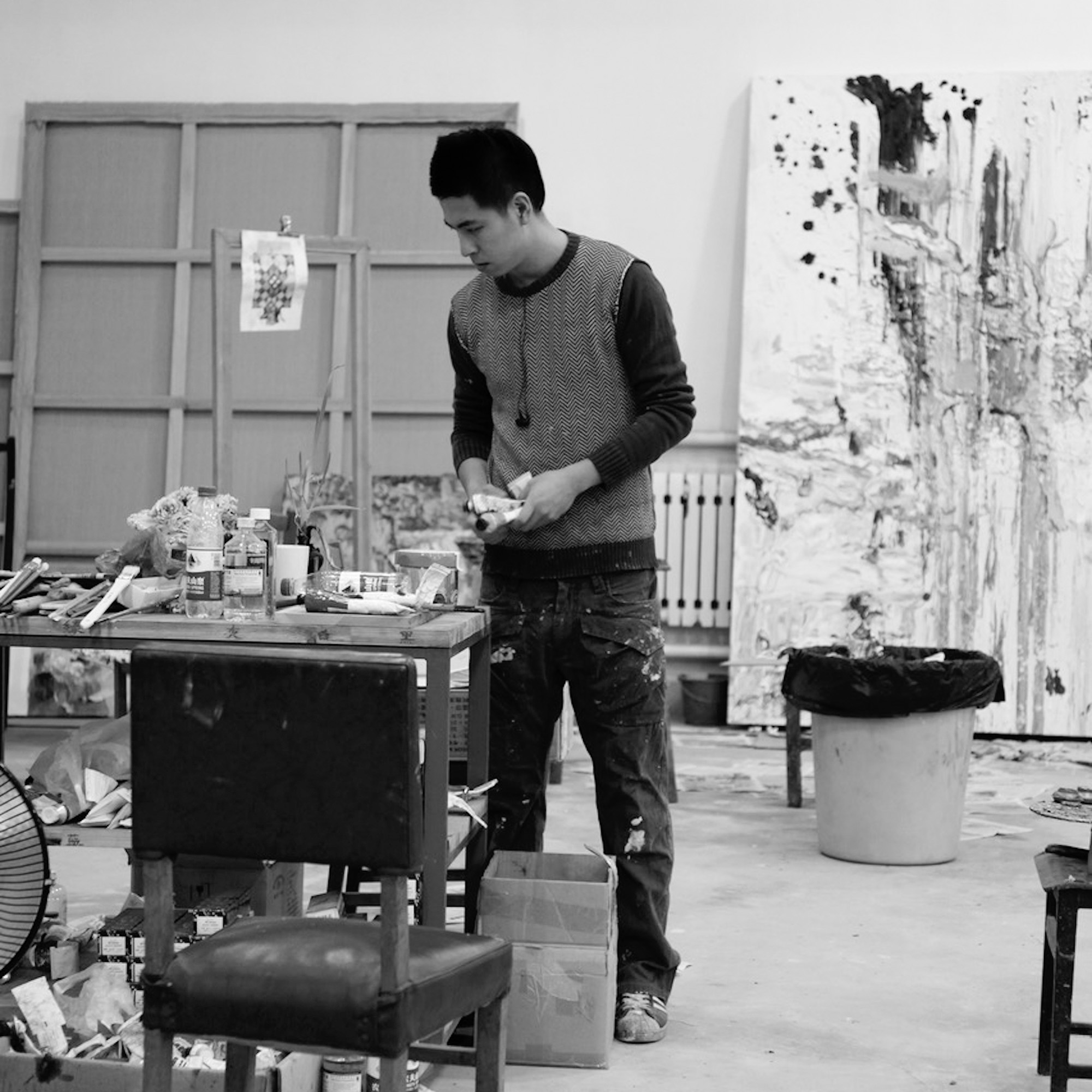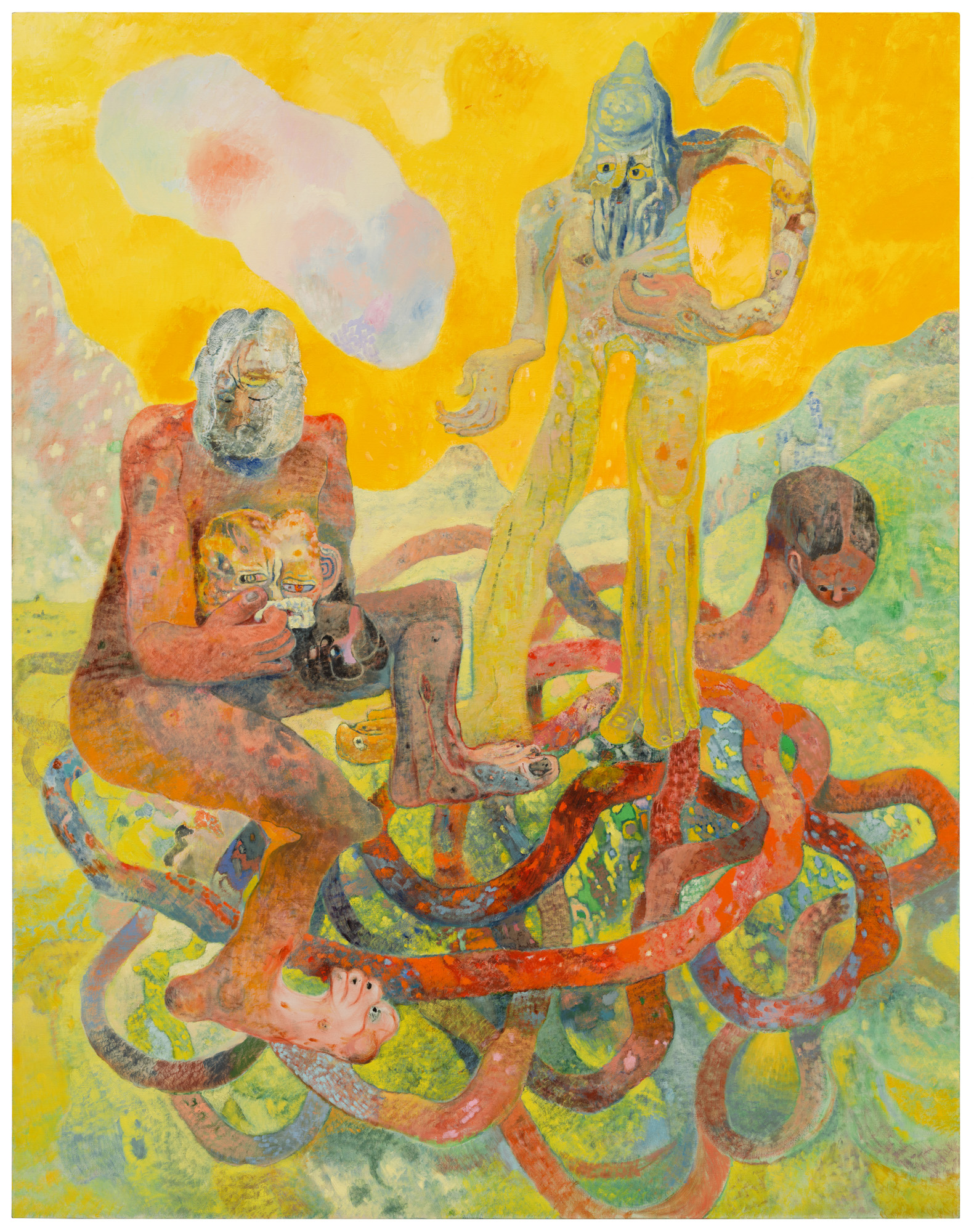Painting as Space-Time Spiral: An Interview with Qiu Xiaofei
By Emily Chun

Portrait of QIU XIAOFEI. All images courtesy the artist and Pace, New York.
A leading figure in the new generation of painters in China, Qiu Xiaofei has consistently and rigorously pursued questions of how painting, a medium that has been around for thousands of years, can still offer fresh potential for meaning-making. “Divination,” Qiu’s solo exhibition at Pace in New York, features his new works from the past two years, and marks the artist’s return to figuration and symbolism. He combines psychological states, the afterlives of family ideologies, and ancient literary sources to produce dream-like, fantastical scenes bathed in jewel tones. I spoke with him about his thoughts on the temporal nature of his paintings, his social inclinations, and how he arrived at the works in the exhibition.
Some of your earlier works, like the ones at your 2016 solo show “Double Pendulum,” at Pace, New York, are more abstract, with highly gestural paint handling and almost no figuration. In the canvases of “Divination,” figures and symbols seem to be more prominent. What kind of desires drove this stylistic change? And how do you conceptualize this current show within the broader arc of your practice?
Before 2010, my works were mostly inspired by my own memories and self-therapy. After that, I made a gradual transition from realistic paintings that were focused on psychoanalysis to improvisation and abstraction, eschewing predetermined imagery. In recent years, I have returned from abstraction to figurative imagery. This is a continuous, gradual exploration and transformation, just like going up a spiral staircase—every step has a direct bearing on the next one. I always had greater ambitions, trying to fuse together, in the same furnace, geography, personal memories, the heritage of political ideologies, ancient art, and abstract improvisation. The works exhibited in “Divination” are the products of this motivation. I did not discard any of the stages of my previous exploration, but, mobilizing the full power of the mystery that painting has, I embedded these explorations in every layer of the paintings. My hope is to integrate the energies of the past to create a completely new, complex style.

QIU XIAOFEI, Farewell 1, 2018, oil on canvas, 200 × 150 cm.
One of the things I find most interesting about your work is the theme of ideological inheritance. Your grandparents, who lived near the Sino-Soviet border of Harbin, harbored Trotskyist allegiances, and we see ambiguous glimpses of Joseph Stalin and Leon Trotsky’s faces in some of your works in the show, such as Trotskyky Mountain (2021). I’ve found that in many Western societies, ideology (political or otherwise) is often conceived as an individual choice, like a piece of clothing one chooses to wear. But we often inherit residual ideology unconsciously and intergenerationally. Could you speak to how inherited ideologies manifest in your life and practice, and what role it plays?
My maternal grandfather was born in 1908. In 1920, he took part in the social revolution in China and then went to the Soviet Union to study. In the 1950s, he became one of the leaders of the Chinese Communist Party, but was defeated in the struggle for power and labeled as a Trotskyite—one of his political stains. He moved his family from Beijing to Harbin, and the experiences he went through deeply affected my mother, leaving a mark that remained her entire life. My father was born in a literary family—my paternal grandfather was a playwright and my father worked as a stage artist in his troupe. I was born in Harbin and was raised in a household with a government official where the atmosphere was permeated with politics, and a literary household that breathed literature and art. Both households had their own problems in post-Cultural Revolution Chinese society. The ideological images, expressions, and books of my forebears have always accompanied me, so much so that it is hard for me to separate the legacy of ideology from my own daily habits. I think that every person is like this—in life, it is hard to strip yourself down to a pure individual.

QIU XIAOFEI, Trotskyky Mountain, 2021, oil on linen, 150 × 90 cm.
You often talk about the idea of a “spiral structure of time,” in which time does not only manifest in the conditions of “past,” “present,” or “future,” but reveals itself as layered, intersecting lines. I can’t help but think about this in connection to your answer about inherited ideologies, which abolish any clear distinction between past and present. I’m also thinking of what you said in another interview, that your paintings are like “an extended family tree, all blooming forth from the same root.” Do you see your paintings themselves occupying a spiral structure of time, sharing the “same root,” instead of, say, each clearly inhabiting an identifiable “style” period or a circumscribed moment in time?
A painting is a snapshot of a moment in time, but unlike cinema or music, painting has no way of showing changes in space and time within this one moment. Yet our perceptions of the world can be extremely complex, just like the space-time spiral that I talked about. Our brain does not only hold the one instant we are encountering, but also colors it with our memories of the past and hopes for the future. Generations of Eastern and Western artists have used different methods to show this. I reject the so-called “evolution of style”—it is a superficial view. All my paintings point to the same origin, like you said, forming an upward-moving spiral—every new attempt to include experiences of greater complexity incorporates past solutions. The content of my paintings is just a quotation, an excuse. I must, using my own story, reach a more abstract and profound experience, just like religious painters do. A good painter can always, within a narrative that they are not familiar with, reveal with great effect their own existence in that moment in time.
Speaking of religious painters, I read somewhere that you described your lifestyle as “puritan-like,” opting out of art-world events or visits to other exhibitions. Would you say your hermitism is more about a refusal of what's expected of you or taking an intense pleasure in your studio work, or both?
I do not take part in social activities because these events do not nurture and I do not find them fun either. On the contrary, I often have fun and gain something during small gatherings of artist friends, but these are like-minded people, I must add. I have no interest in dining, drinking, and partying, I like serious, uninterrupted, spiritual communication. As soon as I feel bored, I leave. But I am certainly no recluse, I simply do not want to spend my mental energy on things that I have already judged to be worthless to me. After all, painting does not just require reflection and judgment; to give your paintings impetus, you need to put in a lot of time, mental energy, and stamina. I have never felt that this was easy.

Installation view of QIU XIAOFEI
The title of your 2021 exhibition, “Divination,” is derived from a chapter of an ancient Chinese poetry anthology called The Songs of Chu. What about this particular chapter intrigued you? How do ancient works inform your practice?
There is a really interesting contradiction described in The Songs of Chu. When the poet Qu Yuan loses hope and direction in the world, he goes to a fortune teller, hoping that they can solve his problems. Instead, the great fortune teller Zheng Zhanyin gives Qu an answer that leaves him dumbfounded: “The ruler is short but the distance is long.” The deities cannot resolve Qu’s difficulties, and so he has to listen to the choices that his own heart makes. Here, this poem touches on an essential problem—we often become disillusioned by the subjective awareness of humankind and hope to find the answer to our problems in an all-encompassing spiritual system. It is the same as artists using various illusions to break the shackles of inertia. I have always been attracted to the primal, mysterious energy of art. However, this energy must ultimately be controlled by a rational force in order to preserve its essential power, otherwise the energy leaks out, squandered. The state of the world today disillusions and perplexes people, just like it did to Qu’s generation. We ask ourselves, what should I do? Here I discovered a wormhole connecting the art of antiquity with the art of today, like a coincidental contact point in the space-time spiral. However, this point cannot give me a precise answer, rather it reminds me that my consciousness is still split, and this complex feeling of multiplicity is more real and more powerful that any imaginary spiritual refuge.

QIU XIAOFEI, Soviet Emissary, 2020-21, oil on linen, 250 × 200 cm.
Qiu Xiaofei’s “Divination” was on view at Pace, New York, from November 5 to December 18, 2021.







